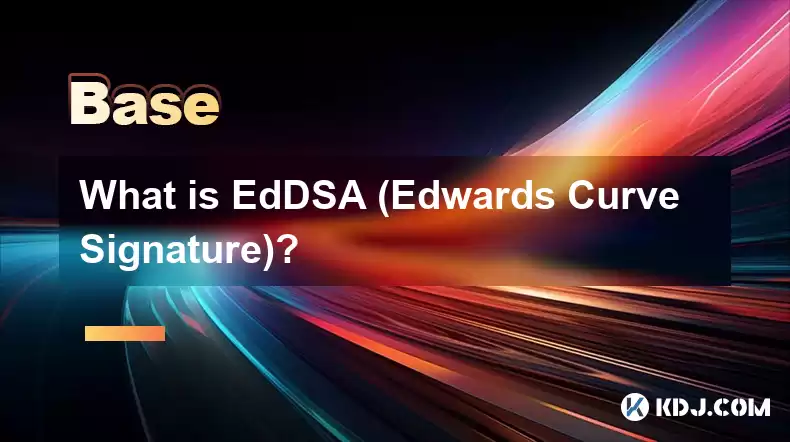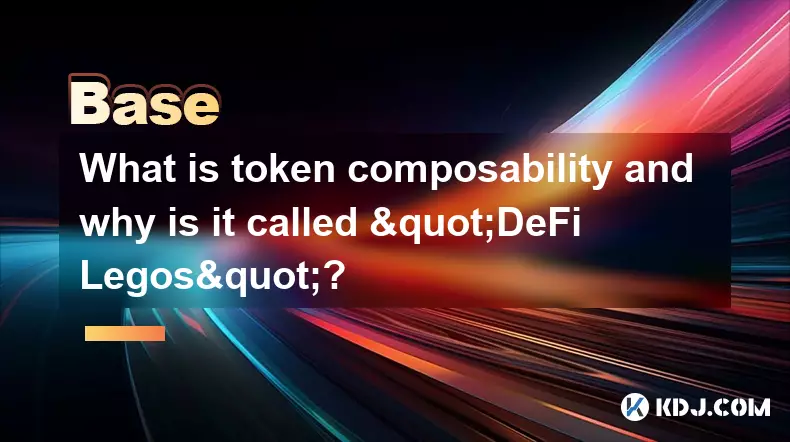-
 bitcoin
bitcoin $101752.865364 USD
-1.09% -
 ethereum
ethereum $3382.985899 USD
-1.38% -
 tether
tether $0.999658 USD
0.04% -
 xrp
xrp $2.272505 USD
-1.51% -
 bnb
bnb $989.089004 USD
0.14% -
 solana
solana $156.962612 USD
-3.08% -
 usd-coin
usd-coin $0.999776 USD
0.01% -
 tron
tron $0.290786 USD
-0.69% -
 dogecoin
dogecoin $0.174594 USD
-2.86% -
 cardano
cardano $0.560085 USD
-3.55% -
 hyperliquid
hyperliquid $40.023704 USD
-5.75% -
 chainlink
chainlink $15.324649 USD
-2.78% -
 bitcoin-cash
bitcoin-cash $493.576540 USD
-3.52% -
 zcash
zcash $571.320038 USD
-12.05% -
 stellar
stellar $0.280066 USD
-4.26%
What is EdDSA (Edwards Curve Signature)?
EdDSA, a modern cryptographic signature scheme, offers high security and efficiency, making it popular in cryptocurrencies like Monero and Cardano.
Apr 07, 2025 at 05:15 pm

EdDSA, or Edwards-curve Digital Signature Algorithm, is a modern cryptographic signature scheme that offers high security and performance. It is based on elliptic curve cryptography and specifically utilizes Edwards curves, which are known for their efficiency and security properties. EdDSA is designed to be simpler and more efficient than other signature schemes, making it a popular choice in various applications, including cryptocurrencies.
h3 The Basics of EdDSAEdDSA is a type of digital signature algorithm that allows a user to sign a message with their private key, and others to verify the signature using the corresponding public key. The algorithm is based on the difficulty of certain mathematical problems related to elliptic curves, which ensures the security of the signatures. EdDSA is particularly noted for its speed and simplicity, making it an attractive option for applications where performance is critical.
h3 How EdDSA WorksThe EdDSA algorithm involves several key steps in the process of signing and verifying a message. Here's a detailed look at how it works:
Key Generation: The first step is to generate a key pair. The private key is a random number, and the public key is derived from the private key using the Edwards curve. The specific curve used in EdDSA is typically Curve25519 or Ed25519.
Signing a Message: To sign a message, the user combines the message with their private key to produce a signature. This involves hashing the message and using the private key to perform operations on the elliptic curve.
Verifying a Signature: To verify a signature, the recipient uses the public key and the message to check if the signature is valid. This involves similar operations on the elliptic curve, but using the public key instead of the private key.
EdDSA offers several advantages over other digital signature algorithms, which contribute to its popularity in the cryptocurrency space:
High Security: EdDSA is designed to be secure against various types of attacks, including side-channel attacks and quantum computer attacks. The use of Edwards curves provides a high level of security with a relatively small key size.
Efficiency: EdDSA is known for its fast performance, both in terms of signing and verifying signatures. This makes it suitable for applications where speed is important, such as in blockchain transactions.
Simplicity: The algorithm is relatively simple to implement and understand, which reduces the likelihood of implementation errors. This simplicity also makes it easier to audit and verify the security of the implementation.
EdDSA is widely used in the cryptocurrency world due to its security and efficiency. Some notable examples include:
Monero: Monero uses EdDSA for its ring signatures, which provide enhanced privacy for transactions. The use of EdDSA helps ensure that the signatures are secure and efficient.
Cardano: Cardano employs EdDSA for its digital signatures, which are used to secure transactions on the blockchain. The efficiency of EdDSA helps improve the overall performance of the Cardano network.
Zcash: Zcash uses EdDSA as part of its zk-SNARKs (zero-knowledge succinct non-interactive arguments of knowledge) to provide privacy and security for transactions.
Implementing EdDSA in a cryptocurrency application involves several steps. Here's a detailed guide on how to do it:
Choose the Curve: The first step is to choose the Edwards curve to use. The most common choice is Ed25519, which is widely supported and offers a good balance of security and performance.
Generate Key Pair: Use a cryptographic library to generate a key pair. The private key should be a random number, and the public key should be derived from the private key using the chosen curve.
Example in Python using the
cryptographylibrary:from cryptography.hazmat.primitives.asymmetric import ed25519private_key = ed25519.Ed25519PrivateKey.generate()public_key = private_key.public_key()
Sign a Message: To sign a message, use the private key to generate a signature. The message should be hashed before signing.
Example in Python:
from cryptography.hazmat.primitives import hashesfrom cryptography.hazmat.primitives.asymmetric import ed25519message = b'Hello, World!'signature = private_key.sign(message)
Verify a Signature: To verify a signature, use the public key and the message to check if the signature is valid.
Example in Python:
from cryptography.hazmat.primitives import hashesfrom cryptography.hazmat.primitives.asymmetric import ed25519message = b'Hello, World!'try:
public_key.verify(signature, message) print('Signature is valid')except:
print('Signature is invalid')
While EdDSA is considered secure, there are several important considerations to keep in mind when implementing it:
Randomness: The security of EdDSA relies on the randomness of the private key. It's crucial to use a secure random number generator to generate the private key.
Key Management: Proper key management is essential to prevent unauthorized access to the private key. This includes securely storing the private key and ensuring that it is not exposed during use.
Implementation Errors: Even though EdDSA is relatively simple, implementation errors can still occur. It's important to use well-tested cryptographic libraries and to thoroughly audit the implementation.
A: EdDSA is specifically designed to work with Edwards curves, such as Ed25519. While it is theoretically possible to adapt the algorithm to other types of elliptic curves, doing so would require significant modifications and could potentially compromise the security and efficiency of the algorithm.
Q: How does EdDSA compare to ECDSA in terms of performance?A: EdDSA generally offers better performance than ECDSA, both in terms of signing and verifying signatures. EdDSA is designed to be faster and more efficient, making it a preferred choice for applications where performance is critical.
Q: Is EdDSA resistant to quantum computing attacks?A: EdDSA is considered to be more resistant to quantum computing attacks than some other signature schemes, but it is not completely immune. While the use of Edwards curves provides a higher level of security, the advent of sufficiently powerful quantum computers could potentially break the security of EdDSA. Research into post-quantum cryptography is ongoing to address this concern.
Q: Can EdDSA be used for other cryptographic purposes besides digital signatures?A: EdDSA is primarily designed for digital signatures, but the underlying elliptic curve cryptography can be used for other purposes, such as key exchange and encryption. However, for these other applications, different algorithms and protocols would typically be used.
Disclaimer:info@kdj.com
The information provided is not trading advice. kdj.com does not assume any responsibility for any investments made based on the information provided in this article. Cryptocurrencies are highly volatile and it is highly recommended that you invest with caution after thorough research!
If you believe that the content used on this website infringes your copyright, please contact us immediately (info@kdj.com) and we will delete it promptly.
- Ripple (XRP) in 2026: Hold or Fold? A Look at XRP's Future and Emerging DeFi Alternatives
- 2025-11-08 18:35:01
- Zcash ZEC Coin Price Explosion: From Privacy Niche to Center Stage
- 2025-11-08 18:55:01
- Berachain Price Prediction: Navigating the Honeycomb Hype in Crypto
- 2025-11-08 18:55:01
- Arthur Hayes, Gold, and Bitcoin: A Modern Monetary Trinity?
- 2025-11-08 19:15:01
- Shiba Inu's Next Move: Navigating a Shifting Market
- 2025-11-08 19:20:01
- Pakistan's Crypto Crossroads: Balancing Opportunity with Asset-Backed Realities
- 2025-11-08 19:20:01
Related knowledge

How does a crypto insurance protocol work?
Nov 08,2025 at 12:39am
Understanding Crypto Insurance Protocols1. A crypto insurance protocol operates by offering financial protection against losses incurred from digital ...

What is token composability and why is it called "DeFi Legos"?
Nov 09,2025 at 06:39am
Bitcoin's Role in Decentralized Finance1. Bitcoin remains the cornerstone of decentralized finance, serving as a benchmark for value and trustlessness...

What is an "exploit" versus a "hack" in the context of smart contracts?
Nov 09,2025 at 12:40am
Understanding Exploits in Smart Contracts1. An exploit refers to the utilization of a known vulnerability within a smart contract’s code to gain unint...

What is a decentralized storage network and how does it compare to cloud services?
Nov 07,2025 at 11:59pm
Understanding Decentralized Storage Networks1. A decentralized storage network distributes data across a peer-to-peer infrastructure rather than relyi...

How do you use a hardware wallet with a software wallet like MetaMask?
Nov 09,2025 at 04:20am
Connecting a Hardware Wallet to MetaMask1. Ensure your hardware wallet is updated with the latest firmware. Devices like Ledger or Trezor require up-t...

What is a factory contract and how is it used to deploy other contracts?
Nov 08,2025 at 04:20am
Understanding Factory Contracts in Blockchain Development1. A factory contract is a smart contract designed to create and deploy other smart contracts...

How does a crypto insurance protocol work?
Nov 08,2025 at 12:39am
Understanding Crypto Insurance Protocols1. A crypto insurance protocol operates by offering financial protection against losses incurred from digital ...

What is token composability and why is it called "DeFi Legos"?
Nov 09,2025 at 06:39am
Bitcoin's Role in Decentralized Finance1. Bitcoin remains the cornerstone of decentralized finance, serving as a benchmark for value and trustlessness...

What is an "exploit" versus a "hack" in the context of smart contracts?
Nov 09,2025 at 12:40am
Understanding Exploits in Smart Contracts1. An exploit refers to the utilization of a known vulnerability within a smart contract’s code to gain unint...

What is a decentralized storage network and how does it compare to cloud services?
Nov 07,2025 at 11:59pm
Understanding Decentralized Storage Networks1. A decentralized storage network distributes data across a peer-to-peer infrastructure rather than relyi...

How do you use a hardware wallet with a software wallet like MetaMask?
Nov 09,2025 at 04:20am
Connecting a Hardware Wallet to MetaMask1. Ensure your hardware wallet is updated with the latest firmware. Devices like Ledger or Trezor require up-t...

What is a factory contract and how is it used to deploy other contracts?
Nov 08,2025 at 04:20am
Understanding Factory Contracts in Blockchain Development1. A factory contract is a smart contract designed to create and deploy other smart contracts...
See all articles





















![The Graph Price Prediction [GRT Crypto Price News Today] The Graph Price Prediction [GRT Crypto Price News Today]](/uploads/2025/11/07/cryptocurrencies-news/videos/690d4df44fe69_image_500_375.webp)



















































